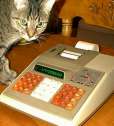Hewlett-Packard HP-27S
| Datasheet legend
Ab/c:
Fractions calculation
AC: Alternating current BaseN: Number base calculations Card: Magnetic card storage Cmem: Continuous memory Cond: Conditional execution Const: Scientific constants Cplx: Complex number arithmetic DC: Direct current Eqlib: Equation library Exp: Exponential/log functions Fin: Financial functions Grph: Graphing capability Hyp: Hyperbolic functions Ind: Indirect addressing Intg: Numerical integration Jump: Unconditional jump (GOTO) Lbl: Program labels LCD: Liquid Crystal Display LED: Light-Emitting Diode Li-ion: Li-ion rechargeable battery Lreg: Linear regression (2-var. stats) mA: Milliamperes of current Mtrx: Matrix support NiCd: Nickel-Cadmium recharg. batt. NiMH: Nickel-metal-hydrite rech. batt. Prnt: Printer RTC: Real-time clock Sdev: Standard deviation (1-var. stats) Solv: Equation solver Subr: Subroutine call capability Symb: Symbolic computing Tape: Magnetic tape storage Trig: Trigonometric functions Units: Unit conversions VAC: Volts AC VDC: Volts DC |
| ||||||||||||||||||||||||||||||||||||||||||||||||||||||||
Hewlett-Packard HP-27S
 The HP-27S is one of the most unusual in Hewlett-Packard's Pioneer series of calculators. It is a do-everything scientific calculator with a significant amount of user memory; however, it is not a keystroke-programmable machine. Programming/customization is accomplished through formulae and the "SOLVE" application.
The HP-27S is one of the most unusual in Hewlett-Packard's Pioneer series of calculators. It is a do-everything scientific calculator with a significant amount of user memory; however, it is not a keystroke-programmable machine. Programming/customization is accomplished through formulae and the "SOLVE" application.
Just how do-everything a machine is it? Well, judge for yourself. The uncluttered keyboard may mislead you; this machine has a full compliment of scientific functions and a lot more. It has a real-time clock and calendar. A beeper. An infrared printer port. Hexadecimal/octal/binary modes of operation. Probability and statistics. Even financial functions (TVM.) Add to that nearly 7 kilobytes of user memory to be used for variables and formulae, and you have a pretty powerful package (in fact, its parameters are comparable to those of the fabled HP-42S.)
But no real programmability. Although it does have the capability of conditional execution and loop structures inside formulae, those are a poor substitute for proper program capability. Or are they? This calculator apparently does have many fans who believe that this, in fact, is one of the best designed machines HP ever made. And considering that it is indeed a very good calculator, who am I to argue? What a pity it's gone extinct years ago, along with the HP-42S and other fabulously good HP models...
Demonstrating the formula programming model of this calculator, here is another implementation of my favorite example, the Gamma function. This implementation actually uses an undocumented feature found on several HP calculators equipped with "SOLVE", the L-function, which allows you to define a local formula within another and reuse it later. With its help, the formula below incorporates an iteration that extends its range to all real arguments including negative numbers:
G=(-1)^L(Q:Σ(I:X:0:1:1))×EXP(LN(2.50662827511×(X+Q)^6+ 83.8676043424×(X+Q)^5+1168.92649479×(X+Q)^4+ 8687.24529705×(X+Q)^3+36308.2951477×(X+Q)^2+ 80916.6278952×(X+Q)+75122.633153)-Σ(I:0:6:1:LN(X+Q+I))+ (X+Q+.5)×LN((X+Q)+5.5)-X-Q-5.5-Σ(I:X:0:1:LN(-I)))


